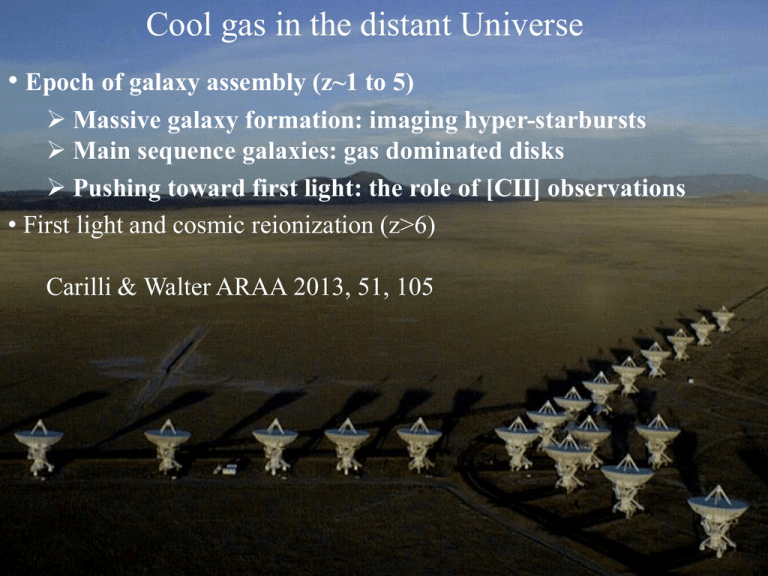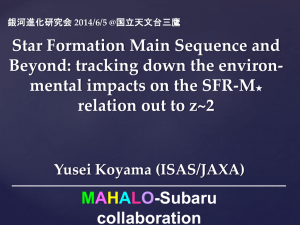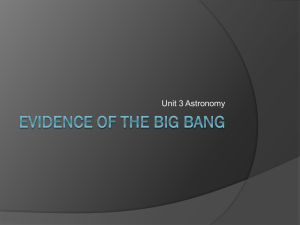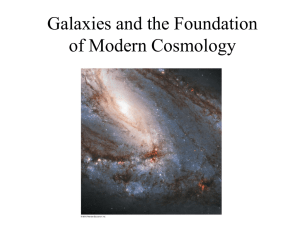High z galaxies Vatican Summer School, June 2014
advertisement

Cool gas in the distant Universe • Epoch of galaxy assembly (z~1 to 5) Massive galaxy formation: imaging hyper-starbursts Main sequence galaxies: gas dominated disks Pushing toward first light: the role of [CII] observations • First light and cosmic reionization (z>6) Carilli & Walter ARAA 2013, 51, 105 Star formation history of the Universe: UV, radio, IR… UV, 24um First light + cosmic reionization ‘epoch of galaxy assembly’ ~50% of present day stellar mass produced between z~1 to 3 Cosmic demise Star formation history as a function of LFIR (~ SFR) Murphy ea SFR < 30 Mo/yr SFR ~ 100 Mo/yr SFR > 300 Mo/yr FIR > 1012Lo • SFRD shifts to higher SFR galaxies with redshift • Massive galaxies form most stars quickly and early Stellar populations at z=0 Old, red galaxies at z~2 to 3 Cool gas detections at z>1 over time Dec 2011 (pre-ALMA/JVLA) (FIR~1013 HyLIRG Lo) ‘starburst’: SFR ≥ 103 Mo/yr ρ ≤ 10-5 Mpc-3 Main sequence (FIR≤1012 Lo): SFR ≤ 102 Mo/yr, ρ ≥ 10-4 Mpc-3 Rapid rise 2009 – 2012 New instrumentation (Bure, VLA, GBT) New CO discoveries: Main Sequence galaxies (sBzK/BX/BM…) • Low z: main seq + SB + quasar hosts • High z: luminous quasar host galaxies • All cases: preselected on other properties complementarity of different frequency bands redshift coverage and detections: CO lines redshift coverage and detections: other lines Multi-line spectroscopy Spectroscopic imaging ‘nch x 1000 words’ Bure VLA VLA CSG Quasar SMG Submm galaxies • Sources identified with first 250/350 GHz bolometer surveys w. mJy sensitivity w. JCMT, IRAM 30m (1998) • What are they? Distant galaxies? Nearby galaxies? Galactic dust? Rocks in interplanetary medium? SCUBA Bolometer camera: direct detector at submm wavelengths (850um) Dust and the Magic of (sub)mm ‘cosmology’: distance independent method of studying objects in universe from z=0.8 to 10 • Similar, but less pronounced, for mol. lines: lines αRJ ≤ 2, but dust αRJ ≥ 3 • Homework: make this plot and change your life! αRJ 1mm Difficulty: astrometry and confusion 1” Typical resolution submm surveys ~ 3” – 5” => multiple candidate galaxies Redshift distribution: Radio photometric redshifts • 70% detected at 1.4GHz at S1.4 > 30uJy • If high z starbursts following radio-FIR correlation: zpeak ~ 2.2, most at z=1 to 3 Spectroscopic confirmation z=3 • Radio IDs => arcsec astrometry • Blind Keck spectra of radio position • Confirmed via CO spectroscopy • Peak z ~ 2.5, substantial tail to high z • Factor 1000 increase in number density of HyLIRGs from z=0 to 2! Submm galaxy properties See: Narayanan et al. 2014, Phys Rep • SFR > 103 Mo/yr (FIR > 1013 Lo HyLIRGs) • Often major gas rich mergers (but not always) • Usually dust obscured • Always detected in CO: Mgas > 1010 (α/0.8) Mo • Clustering => massive halos 1.4GHz + i-band GN20 ‘SMG group’ at z=4.05: clustered massive galaxy formation 0.7mJy 0.4mJy GN20 z=4.055 + + + + 5” 0.3mJy GN20.2b 4.056 + + + + + • Over-density: 19 LBGs at zph ~ 4 within ~ 1 arcmin • VLA 45GHz, 256MHz BW: CO2-1 from 3 SMGs + GN20.2a 4.051 CO 2-1 Mom0 1” 1” 0.25” HST/CO/SUBMM GN20 z=4.05 • FIR = 2 1013 Lo • Highly obscured at I band • CO: large, rotating, disk ~ 14 kpc +11 M • Mdyn = 5.4 10 o • Mgas = 1.3 1011 (α/0.8) Mo Mom1 -250 km/s +250 km/s Hodge ea 2012 CO at HST-resolution: 0.15” ~ 1kpc 0.5” • Tb ~ 20K, σv ~ 100 km/s • Self-gravitating super-GMCs? Mdyn ~ Mgas ~ 109 (α/0.8) Mo Hodge ea 2012 10 Submm galaxies: Building a giant elliptical galaxy + SMBH at tuniv< 2Gyr Multi-scale simulation isolating most massive halo in 3 Gpc^3 Stellar mass ~ 1e12 Mo forms in series of major, gas rich mergers from z~14, with SFR 1e3 Mo/yr 6.5 SMBH of ~ 2e9 Mo forms via Eddington-limited accretion + mergers Evolves into giant elliptical galaxy in massive cluster (3e15 Mo) by z=0 Li, Hernquist et al. • Rapid enrichment of metals, dust in ISM • Rare, extreme mass objects: 0.1 arcmin-2 CO in Main Sequence galaxies CO1-0 z=1.5 GN 20, 1’ field 256MHz BW 3 z=4 SMGs 1 sBzK at z=1.5 CO2-1 z=4.0 Serendipity becomes the norm! Every observation with JVLA at ≥ 20GHz, w. 8 GHz BW will detect CO in distant Main sequence: sBzK/BX/BM at z ~ 1 to 3 HST 4000 A Ly-break z=1.7 color-color diagrams: thousands of z~ 2 star forming galaxies SFR ~ 10 to 100 Mo/yr, M* ≥ 1010 Mo ~ ‘typical SF galaxies’ See Shapley 2011 ARAA, 49, 525 Color selected or ‘Main Sequence’ galaxies Elbaz ea SMGs SFR 10kpc sBzK/BX/BM – ‘main sequence’ Mstar Define a ‘main sequence’ in Mstar – SFR, clearly delineated from SMGs (‘starburst’) HST => clumpy disk, sizes ~ 1”, punctuated by massive SF regions CO obs of Main Sequence galaxies Daddi ea. 2010 6 of 6 sBzK detected in CO CO luminosities approaching SMGs but, FIR (SFR) ≤ 10% SMGs Massive gas reservoirs without hyper-starbursts! PdBI imaging (Tacconi) • CO galaxy size ~10 kpc • Clear rotation: vrot ~ 200 km/s • SF clump physics Giant clumps ~ 1 kpc Mgas ~ 109Mo Turbulent: σv > 20 km/s SMG (HyLIRG) Main sequence (ULIRG) • • • • • • • • LIR = 2e13 Lo T = 33K, b = 2.1 Md = 2e9 Mo G/D = 75 LIR = 2e12 Lo T = 33K, b=1.4 (larger dust) Md = 9e8 Mo G/D = 104 Conversion factor: L’CO = α MH2 • Mdyn: using CO imaging, w. norm. factors from simulations Hodge ea. -300 km/s 7kpc • Subtract M*, MDM , assume rest is Mgas => CSG: α CO ~ 4 ~ MW SMG: αCO ~ 0.8 ~ nuclear SB GN20 z=4.0 Mdyn = 5.4 1011 Mo Consistent with: +300 km/s Mdyn = 2 1011 Mo Analysis based on SF laws (Genzel) Analysis of dust-to-gas ratio vs. metallicity (Magdis ea) Radiative transfer modeling (Ivison) Likely increases w. decreasing metalicity (Tacconi, Genzel) z=1.1 Tacconi ea. 2010 Star Formation Law: two sequences (disk – starburst) • PL index = 1.4 • Gas depletion time td = Mgas/SFR disk: td ~ few (α/4) x 108 yrs starburst: td ~ few (α/0.8) x 107 yrs SF efficiency = 1/td N=1.42 Why: All processed on dynamical time? • Normalize by dynamical time (~ rotation period) • Linear slope fits all => tdeplete/tdyn ~ constant The free fall time is shorter in denser SB disks: tff ~ R/vrot ~ ρ-1/2 n=1.14+-0.03 CO excitation quasars ~ constant Tb to high order ~ Arp220 nucl. ~ GMC SF core SMGs: intermediate between nuc. SB and MW Often large, cooler gas component CSG ~ MW excitation (1 case) z >1 quasars ν2 Arp220 SMGs . . .Main Seq MW MW ~ GMC (30 pc), T ~ 20K, nGMC ~ 102 cm-3 Arp220 ~ SF cores (1pc), ncore > 104 cm-3 , T > 50K MS: Baryon fraction is dominated by cool gas, not stars Daddi ea 2010 sBzK z~1.5 z~0 spirals • Possible increase with decreasing Mstar Tacconi ea 2013 Emerging paradigm in galaxy formation: cold mode accretion (Keres, Dekel…) • Galaxies smoothly accrete cool gas from filamentary IGM onto disk at ~ 100 Mo/yr (high density allows cooling w/o shocks) • Fuels steady star formation for ~ 1Gyr • Form turbulent, rotating disks with kpcscale star forming regions, which migrate inward over ~ 1 Gyr to bulge • ‘Dominant mode of star formation in Universe’ • Problems: Circumstantial evidence: No direct observation of accreting gas CMA challenged in recent cosmological simulations T<105K, N>1020 cm-2 Cerverino + Dekel Evolution of gas fraction: epoch of peak cosmic SF rate density (z~2) = epoch of gas-dominated disks ~ L’CO/R (1+z)2 • All star forming disk galaxies w. M* ≥ 1010 Mo • All points assume α~ 4 => empirical ratio ~ L’CO/Rrest Good news for molecular deep fields • JVLA: 25% FBW 31 to 39 GHz => Large cosmic volume searches for molecular gas CO 1-0 at z=1.9 to 2.7 CO 2-1 at z = 4.9 to 6.4 FoV ~ 1.5’ Good news for molecular deep fields: PdBI pilot search • Spectral scan: 80 to 115GHz • Detect 5 candidate CO galaxies HDF 850.1: z = 5.2 (finally!) 1’ 850.1 CSG z = 1.78 • JVLA/ALMA searches in progress zph = 1.78 850.1 z=5.2 CO deep fields: VLA GN, Cosmos • • • • 150 hrs ; rmscont~ 3uJy 30 – 38 GHz 10, 50 arcmin2 rms per 100km/s < 0.1mJy => MH2 = few e9 Mo • 1st cool CO selected ~ dusty main sequence SFR ~ 250 Mo/yr z=2.5 MH2 = 7e10 Mo Goods North 50 arcmin2 Cool Gas History of the Universe SF Law SFR Mgas • SFHU[environment, luminosity, stellar mass] has been delineated in remarkable detail back to reionization • SF laws => SFHU is reflection of CGHU: study of galaxy evolution is shifting to CGHU (source vs sink) • Epoch of galaxy assembly = epoch of gas dominated disks Pushing back to first (new) light: Fine structure lines Good news: CII is everywhere! • [CII] 158um line (1900GHz) is most luminous line from star forming galaxies from meter to FIR wavelengths: 0.3% of FIR luminosity of MW [CII]/CO3-2 ~ 50 • traces WNM, WIM, SF regions => Good dynamical tracer • z > 1 => redshifts to ALMA bands (< 900 GHz) Bad news: CII is everywhere! CII luminosity is not quantitative tracer of anything: FIR > 1011 => 20dB scatter! [CII] powerful tool for: • Gas dynamics (CNM – PDR) • Redshift determinations z>6 Low metallicity: enhanced [CII]/FIR (lower dust attenuation => large UV heating zone) Can be suppressed in SB nuclei: dust opacity? Mag. Clouds MW 11 [CII] examples: New field (all within last year!) Dust-obscured hyper-starbursts Imaging massive galaxy formation B1202-07 z=4.7 G3 SMG G3 700km/s 2” G4 G4 QSO rms=100uJy • Two hyper-starbursts (SMG and quasar host): SFR ~ 103 Mo/yr • Two ‘normal’ LAE: SFR ≤ 102 Mo/yr SMG [CII] in 1202: Imaging cool gas dynamics at z=4.7 • Quasar, SMG: Broad, strong lines • Tidal bridge across G3, as expected in gas-rich merger • Possible quasar outflow, or further tidal feature, toward G4 G3 Q G4 BRI1202: ‘smoking gun’ for major merger of gas rich galaxies -500km/s 7kpc SMG G3 Q G4 +500km/s ALMA: 20min, 17ant • Tidal stream connecting hyper-starbursts • SMG: warped disk, highly optically obscured • HyLIRG QSO host, with outflow seen in [CII] and CO • G3: Ly-alpha + [CII] in tidal gas stream • G4: dust and [CII] in normal LAE Aztec 3: massive cluster formation at z=5.3 ALMA 1hr, 17ant Riechers ea rms = 70uJy Capak ea 2012 • SMG SFR ~ 1800, Mgas ~ 5e10 (α/0.8) Mo • Most distant proto-cluster: 11 LBGs in ~ 1’; 5 w. zspec ~ 5.30 ALMA observations [CII] 158um line from Aztec 3 group (Riechers) SMG • Roughly face-on, size ~ 8kpc • Mdyn ~ 1011 Mo • [CII]/FIR ~ 0.001 ~ ‘starburst/AGN’ Detect LBG group in [CII] • No FIR: S300 < 0.2mJy => SFR < 50 Mo/yr • [CII]/FIR > 0.0023 ~ MW • Tidally disturbed gas dynamics in interacting LBG group Representative sample Main Sequence galaxies z=5 – 6 (LBGs) • SFRs ~ 30 to 300 Mo/yr • 10/10 detected in [CII] w. ALMA 1hr, 22 ants. • Only 4 detected in dust continuum [CII]/FIR: similar large scatter to low redshift Galaxy dynamics at z=5.7 -125 to +125 km/s Cosmic reionization and beyond: redshifts for first galaxies J1120+0641: z=7.084 Most distant zspec Mortlock ea;Venemans ea. • GP effect: damped profile of neutral IGM wipes-out Lya line: τIGM > 5 • [CII] and dust detected with Bure => SFR ~ 300 Mo/yr • ISM of host galaxy substantially enriched (but not IGM; Simcoe ea.) Pushing further into reionization: z~9 near-IR dropouts Bouwens et al. 2012 • Drop-out technique: z~9 galaxies? • SFR ~ few to ten Mo/yr: low SFR galaxies that reionize the Universe? • Difficulty: confirming redshifts (no Lya!) • ALMA: [CII] from 5Mo/yr at z=7 in 1hr; 8GHz BW => Δz ~ 0.3 • Low Metalicities => [CII]/FIR increases! Quasar hosts: Dynamics of first galaxies Dust Wang ea Gas -200 km/s +300 km/s 300GHz, 0.5” res 1hr, 17ant ALMA Cycle 0: 5/5 detected [CII] + dust Sizes ~ 2-3kpc, clear velocity gradients Mdyn ~ 5e10 Mo, MH2 ~ 3e10 (α/0.8) Mo •Maximal SB disk: 1000 Mo yr-1 kpc-2 Self-gravitating gas disk, support by radiation pressure on dust grains ‘Eddington limited’ eg. Arp 220 on 100pc scale, Orion < 1pc scale Mbh/Mdyn vs. inclination for z=6 QSOs Low z relation All must be face-on: i < 20o Need imaging! • Correlation has become scatter • Possibly sub-correlations • See Kormendy & Ho ARAA Cooling flow problem • Tcool = ?? < thubble • Radio jet energy input is enough to keep the gas hot CO in Main sequence CO1-0 z=1.5 GN 20, 1’ field 256MHz BW 3 z=4 SMGs 1 sBzK at z=1.5 CO2-1 z=4.0 Serendipity becomes the norm! Every observation with JVLA at ≥ 20GHz, w. 8 GHz BW will detect CO in distant









